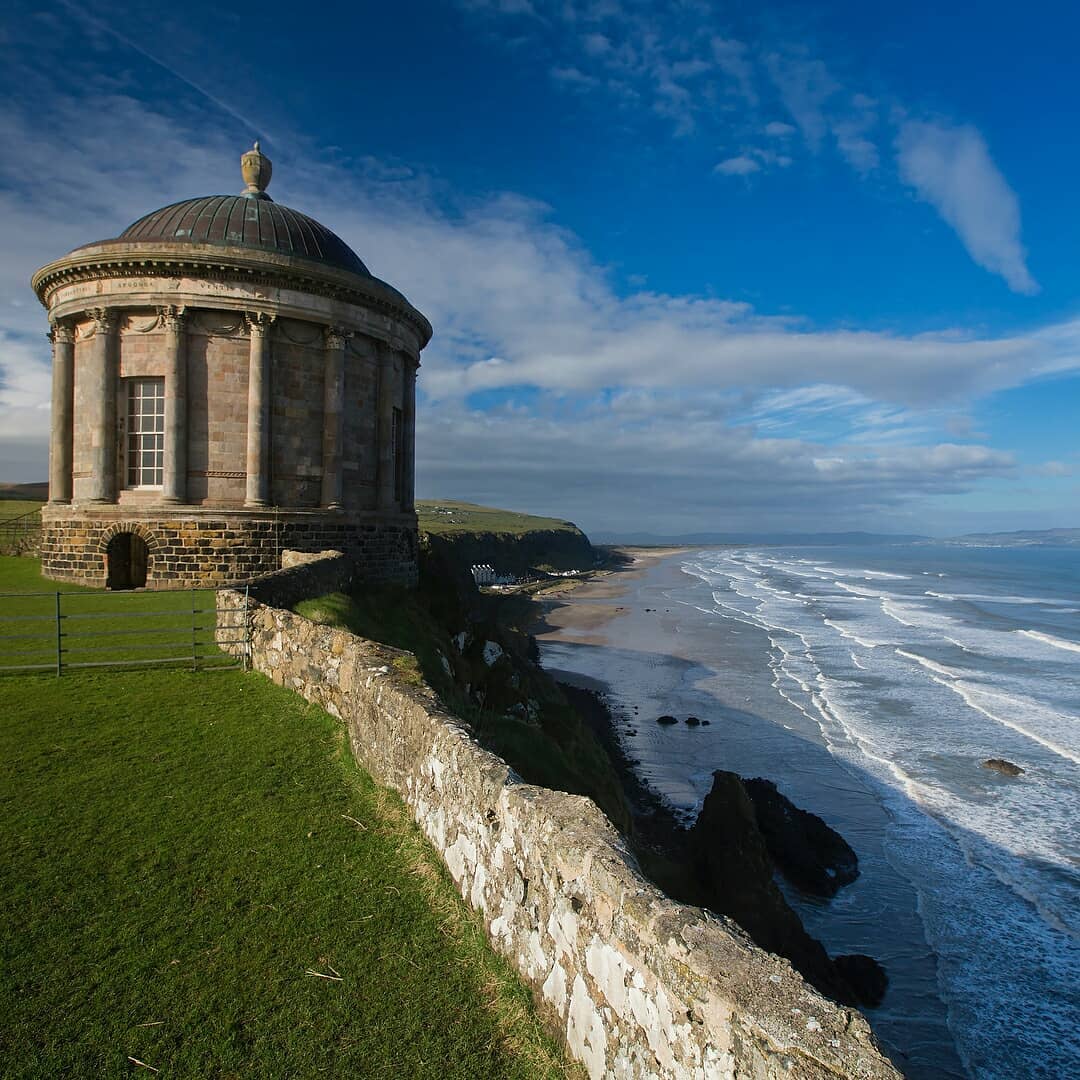Mussenden Temple
Mussenden Temple is located in the stunning surroundings of Downhill Demesne on the North Coast of Ireland, not far from the small town of Castlerock in Co. Londonderry. The Temple itself sits precariously at the brink of the cliff edge, towering 120ft cliffs overlooking Loch Foyle towards Donegal and the Atlantic Ocean.
The scenic views and pathways around Downhill Demesne Mussenden Temple offer a breathtaking experience for visitors. Mussenden Temple and its surrounding views are among some of the most photographed scenes in Ireland. The Temple itself was for many years, under threat of being lost to the sea due to the erosion by the Atlantic Ocean of the cliffs on which the Temple stands, bringing it closer to the edge and ruin. It was once possible to drive around the Temple in a carriage. The National Trust, as caretakers of the estate, then carried out cliff stabilisation work in 1997 to prevent the loss of this iconic building being consumed by the sea.
The main buildings, Downhill House, along with Mussenden Temple have all the hallmarks of an 18th-century aristocrat’s neo-classical residence. The Temple itself is more of a vanity building, built in 1785 by The Lord Bishop of Derry, Frederick Hervey, as his private library.
The building it is thought was based on Bramante’s Tempietto (resting place of Hugh O’Neill, on Rome’s Janiculum hill, itself is inspired by the Temple of Vesta at Tivoli near Rome. Micheal Shanahan, the Cork-born architect, who accompanied the Earl Bishop on one of his many visits to Italy, is thought to have designed and built the Temple.
It also serves as a memorial to the Lord Bishop’s young cousin, a Mrs Frideswide Mussenden. Mrs Mussenden, a young mother, died at the age of 22.
The inscription that runs around the building reads: “Suave, Mari Magno turbantibus aequora ventise terra magnum alterius spectare laborem.” Which translates as “Tis pleasant, safely to behold from shoreThe troubled sailor, and hear the tempests roar.” The quotation is from Lucretius, De Rerum Natura, 2.1–2.
Downhill Demense
The main Downhill House began construction in 1775 under the commission of Frederick Hervey, the Earl-Bishop. After his lordship’s death in 1803, his properties went to his heirs, the Bruce family. The house suffered significant damage in 1851 by a fire that almost entirely destroyed the library and nearby parts of the House. Bishop Lord Bristol had amassed an extensive collection of art, which was kept at Downhill. The fire destroyed many works by artists such as Correggio, Dürer, Murillo, Rubens and Tintoretto, although it was reported that most of the paintings had been saved.
The Earl Bishop died in 1803, leaving his estate to his cousin rather than immediate family, reflecting his eccentric character.
Downhill House was restored following the fire between 1870 and 1874 under John Lanyon, the son of famous architect Charles Lanyon, who maintained many of the original features.
During the Second World War, Downhill was used to billet RAF servicemen and women. The Bruce family continued to own the house until 1946; by 1950 however, it had been dismantled and the surrounding land sold. The house was acquired by The National Trust in 1980; the temple had become a Trust property in the 1940s.
After the various mishaps, the National Trust acquired the buildings during the mid 20th century. They provide us with a fascinating window into the past. Downhill House is now a ruin, but the Mussenden Temple is in good shape. We can see a digital reconstruction of both the interior and exterior of these two buildings here.
History
Frederick Hervey was born in 1730. As the third son of the 2nd Earl of Bristol, he didn’t seem likely to inherit titles or property. Therefore, he entered the Anglican church as a career option and became the Bishop of Derry in 1768. After the death of his two childless elder brothers, the Earldom of Bristol passed to him in 1779.
As Bishop of Derry, he had a liberal attitude to other faiths. He believed the future of the Crown depended on fostering good relationships with all communities. He won the respect of the Catholics and the Presbyterians. He oversaw his diocese while building neo-classical mansions in Downhill and Ballyscullion.
On trips to Europe, he acquired valuable works of art to display in his magnificent homes. He also developed his ancestral property at Ickworth in Suffolk.
His marital relationship soured. He appeared to enjoy the company of Mrs Frideswide Mussenden, his Lisburn-based cousin. The unlikely friendship raised a few eyebrows, but it was probably platonic. Mussenden Temple became Mrs Mussenden’s memorial after her demise in 1785, while still in her early twenties.
Although the Earl Bishop built grand houses and collected high art, he didn’t neglect his parish work. Overseeing and leading his diocese, he carried out building works and organised pensions for retired clergymen. He gained popularity with people of all communities. People appreciated him as someone who provided employment and encouraged prosperity.
He also studied the natural phenomenon of the Giant’s Causeway as a volcanic site. He was the first to bring it to the notice of the Royal Society. He was the first prominent personality to popularise the now famous tourist attraction. Downhill House would have basked in his reflected glory.
While the main Downhill House has become ruined over the years owing to unfortunate circumstances, the estate still contains attractive features that are worth a look, here are some of the other areas to have a wander around.
The Earl Bishop’s Gate
The Bishop’s Gate has an impressive Gothic gate lodge, it is also the main entrance to the Walled Gardens and the Black Glen. Have a look at the symbolic carvings, including a bishop’s mitre and several cow skulls.
The Black Glen
<<BlackGlen.jpg>>
This small arboretum is home to a wide variety of trees and is a lovely place to walk, especially to get away from the winds on the cliff-top. See whether you can spot the fish pond, and the statue of the Earl Bishop’s brother – especially his head, no-one has ever found that.
Lion’s gate
Topped by stone snow leopards – they’ve recently been restored and now roar in their former glory. This is one of two entrances to the property.
Lady Erne’s Seat
https://www.instagram.com/p/BpMf7QDntJs/?utm_source=ig_web_copy_link
No one quite knows what this was initially, Is it a mill of some sort, or perhaps the summer-house of the bishop’s daughter Mary? Either way, it’s a lovely quiet spot from which to see the sea, a fitting reward for the climb up from the Black Glen.
The Bog Garden
This fantastic garden close to the Bishop’s Gate is home to an extensive variety of flowers, including some stunning irises. The garden was first created by Lady Bruce in 1910.
The Mausoleum
Really a cenotaph – an empty tomb built as a memorial for the Earl Bishop’s brother, George Hervey. See if you can find the statue of George that was blown off the roof in the Big Wind and now lies in the grounds.
The Mausoleum from The Earl Bishop Trail on Vimeo.
Dovecote and Icehouse
The round building next to the walled garden has a dovecote above, which supplied meat for the Earl Bishop’s table, and an ice house below, for keeping food fresh. The ice was cut at a nearby pond in the winter. You can walk around and through it….but watch out for the doves.
The Walled Garden
Like many great houses, Downhill has a walled garden. This once provided fruit, vegetables, and even flowers for the Earls. Now it houses sheep and apple trees. You can get access to the dovecote. We recommend its sheltered lawns that are perfect for a picnic.
Myths & Legends about Downhill House
One of the biggest myths about the history of the Downhill Demesne is the notion that the Earl Bishop and Frideswide Mussenden were lovers. Downhill House, commissioned by Frederick Hervey, the Earl-Bishop, after he became Bishop of Derry in 1768, was the Earl Bishop’s first building in Ireland, with construction beginning in 1775.
According to popular legend, they trysted in the Temple. There’s a copy online of the painting of the Earl Bishop with a young girl, allegedly ‘Miss Mussenden’. But, Frideswide Mussenden was Mrs Mussenden née Bruce.
The Bruce family were cousins of the Earl Bishop. Frideswide’s brother, Rev. Henry Bruce, represented the Earl Bishop in his absence from Derry. The painting is officially listed as being that of the Earl Bishop and his granddaughter, Lady Caroline Crichton. The girl looks so young, it’s inappropriate in modern times to consider the pair as a couple. The cousins had a 30 year age difference.
Exploring the house provides insight into the Earl Bishop’s life, showcasing his lifestyle and the grandeur of his coastal estate during the late 1800s. The Bishop was eccentric and often behaved unusually for a priest. He would allegedly scatter flour on the floor outside the Downhill bedrooms at night so he could check who had been visiting other bedrooms. Could this be true?
The Bishop had a remarkable collection of art, and it’s said that much of it was destroyed in a fire. The truth is that most of the collection was saved, even if some pieces were not. Other pieces were lost when the Earl Bishop tried to shift them from the continent to Ireland after purchase.
Owing to Napoleonic activity, there was political turmoil in Europe. The Earl Bishop was even arrested and imprisoned as a British spy.
The Earls plan for his two Irish houses was to make them galleries for his art collections. Downhill housed an extensive collection of art and served as the Earl Bishop’s summer home.
Architect Michael Shanahan built the house in neoclassical style. But the design seems to show influences of Charles Cameron and James Wyatt too. So perhaps they had some early input into this design.
Game of Thrones – The Role it Plays on the North Coast Today
The hugely successful HBO drama Game of Thrones has given renewed and broader exposure to the Downhill Demesne. The property and its surroundings provided a backdrop for outdoor shoots of selected scenes in Season 2 of the fantasy drama.
Episode 1 contains a particularly memorable scene featuring the characters Melisandre and Stannis on Downhill Beach, Mussenden Temple was instrumental in filming the Downhill Beach scenes. The building, which overlooks Downhill Beach, provided an excellent viewing point for the film crew. It enabled them to record the scenes filmed at that location.
In the series, Downhill Beach becomes ‘Dragonstone’. This stunning seven-mile stretch of sand, overlooked by mysterious 18th-century ruins, provided a perfect atmosphere. It blended seamlessly into the fantasy world of this ‘sword and sorcery’ drama.
This is where Stannis Baratheon pulled out the flaming sword. It’s where Melisandre chanted ‘the night is dark and full of terrors’. When visitors reach this place, they look around and see what else this location has to offer.
Nowadays, visitors can enjoy many beautiful and scenic walks in the area. Lord Frederick Hervey, the Earl of Bristol and Bishop of Derry, was the first to put this beautiful corner of Earth on the map. But in the digital age, Game of Thrones has catapulted this otherwise little-known spot into a bright future. Game of Thrones has rediscovered this gem, and the world is coming around to check it out. Don’t miss visiting this charming spot, so rich in history and backstory.
How to Get There via Car and Public Transport
Downhill House is a joy to visit. it’s situated in the peaceful rural countryside of Co. Londonderry, between the seaside village of Castlerock and Coleraine.
From Portrush, the easiest way to get to Mussenden Temple and Downhill Demense is by Car. The Temple, which can be seen from the Harbour on clear days, is only about 6 miles as the crow flies from Portrush. The trip takes about 25 mins. Leaving Portrush heading for Coleraine, once in Coleraine follow the Signs for L’Derry and Castlerock. Once you cross the River Bann, turn right at the second round about (you should have passed a retail park on your left), follow the “Greenhall Highway” and over the next roundabout, once you reach the T junction turn left onto the A2 and follow the signposts for Castlerock. There are brown signposts follow these.
However, if you are looking for a scenic route, then we recommend that you follow the A2 (Causeway Coastal Route), it will take you along the coast to Portstewart, along the river Bann, via Coleraine and through Castlerock. Both are worth a stop for the many Cafes.
From Belfast and Dublin, a combination of the M2 and the A26 can help a motorist reach Coleraine from Belfast in about an hour and 10 minutes.
Public Transport
From Portrush you can take the bus (140 or 402) to Coleraine, or the train as they stop in the same terminal. Then change onto the (134) Limavady Bus. There is a bus stop just across the road from the main entrance. The whole journey will take around 45mins to an hour depending on connections.
From Belfast & Beyond
You can also take a bus to Coleraine from Belfast’s Bridge Street. It takes one hour and 40 minutes. The Coleraine bus goes every hour from 6am to 9pm monday to Saturday (Sunday is a reduced timetable). After arriving in Coleraine, there is a bus from Coleraine to Castlerock (see above)
By Train
The train is another great option. The Belfast-Derry train goes every hour (Mon-Sat…Sunday is a reduced service). From Belfast, or Dublin via the Enterprise, you can get off at Castlerock Train station. Castlerock is around 2 km from Downhill Demense and Mussenden Temple. From the train station, you can get the bus (see above) a Taxi (around £7) or, if you’re willing, you could walk the two-kilometres in around half-an-hour, it is a nice walk and there are some stunning views north to donegal and, more importantly, Portrush.


